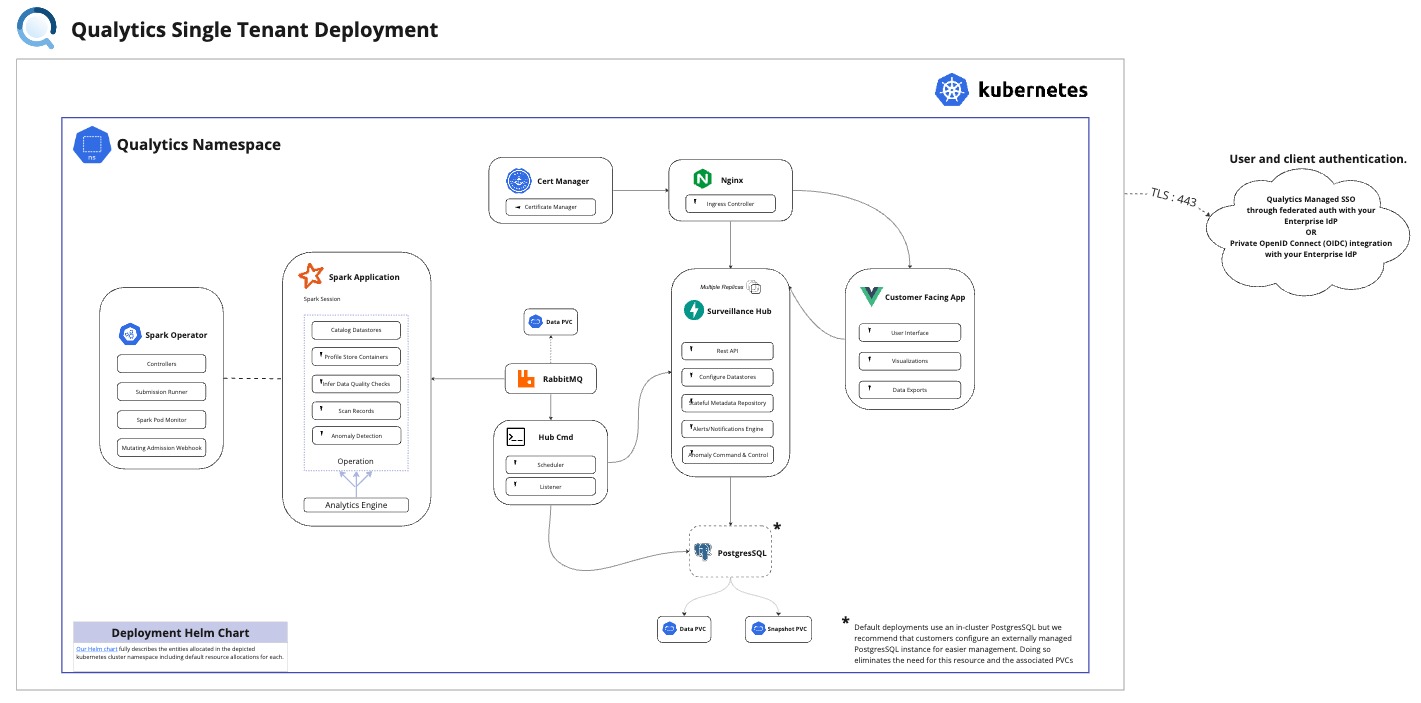Installing helm for Qualytics single-tenant instance
Welcome to the Installation Guide for setting up Helm for your Qualytics Single-Tenant Instance.
Qualytics is a closed source container-native platform for assessing, monitoring, and ameliorating data quality for the Enterprise.
Learn more about our product and capabilities here.
Important Note for Deployment Type
Before proceeding with the installation of Helm for Qualytics Single-Tenant Instance, please note the following:
-
This installation guide is specifically designed for on-premises customers who manage their own infrastructure.
-
If you are a Qualytics Software as a Service (SaaS) customer, you do not need to perform this installation. The Helm setup is managed by Qualytics for SaaS deployments.
If you are unsure about your deployment type or have any questions, please reach out to your Qualytics account manager for clarification.
What is in this chart?
This chart will deploy a single-tenant instance of the qualytics platform to a CNCF compliant kubernetes control plane.

How should I use this chart?
Work with your account manager at Qualytics to securely obtain the appropriate values for your licensed deployment. If you don't yet have an account manager, please write us here to say hello!
At minimum, you will need credentials for our Docker Private Registry and a set of Auth0 secrets that will be used in the following steps.
1. Create a CNCF compliant cluster
Qualytics fully supports kubernetes clusters hosted in AWS, GCP, and Azure as well as any CNCF compliant control plane.
Node Requirements
Node(s) with the following labels must be made available:
appNodes=truesparkNodes=true
Nodes with the sparkNodes=true label will be used for Spark jobs and nodes with the appNodes=true label will be used for all other needs.
It is possible to provide a single node with both labels if that node provides sufficient resources to operate the entire cluster according to the specified chart values.
However, it is highly recommended to setup autoscaling for Apache Spark operations by providing a group of nodes with the sparkNodes=true label that will grow on demand.
| Application Nodes | Spark Nodes | |
|---|---|---|
| Label | appNodes=true | sparkNodes=true |
| Scaling | Fixed (1 node on-demand pricing) | Autoscaling (1 - 21 nodes spot pricing) |
| EKS | t3.2xlarge | r5d.2xlarge |
| GKE | n2-standard-8 | c2d-highmem-8 |
| AKS | Standard_D8_v5 | Standard_E8s_v5 |
Docker Registry Secrets
Execute the command below using the credentials supplied by your account manager as replacements for "your-name" and "your-pword". The secret created will provide access to Qualytics private registry and the required images that are available there.
kubectl create secret docker-registry regcred --docker-server=artifactory.qualytics.io/docker --docker-username=<your-name> --docker-password=<your-pword>
Important
If you are unable to directly connect your cluster to our image repository for technical or compliance reasons, then you can instead import our images into your preferred registry using these same credentials. You'll need to update the image URLs in the values.yaml file in the next step to point to your repository instead of ours.
2. Update values.yaml with appropriate values
Update values.yaml according to your requirements. At minimum, the "secrets" section at the top should be updated with the Auth0 settings supplied by your Qualytics account manager.
auth0_audience: changeme-api
auth0_organization: org_changeme
auth0_spa_client_id: spa_client_id
auth0_client_id: m2m_client_id
auth0_client_secret: m2m_client_secret
auth0_user_client_id: m2m_user_client_id
auth0_user_client_secret: m2m_user_client_secret
Contact your Qualytics account manager for assistance.
3. Deploy Qualytics to your cluster
The following command will first ensure that all chart dependencies are availble and then proceed with an installation of the Qualytics platform.
helm repo add qualytics https://qualytics.github.io/qualytics-helm-public
helm upgrade --install qualytics qualytics/qualytics --namespace qualytics --create-namespace -f values.yaml
As part of the install process, an nginx ingress will be configured with an inbound IP address. Make note of this IP address as it is needed for the fourth and final step!
4. Register your deployment's web application
Send your account manager the IP address for your cluster ingress gathered from step 3. Qualytics will assign a DNS record to it under *.qualytics.io so that your end users can securely access the deployed web application from a URL such as https://acme.qualytics.io
Upgrade Qualytics Helm chart
Do you have the Qualytics Helm chart repository locally?
Make sure you have the Qualytics Helm chart repository in your local Helm repositories. Run the following command to add them:
Update Qualytics Helm Chart:
Target Helm chart version?
The target Helm chart version must be higher than the current Helm chart version.
To see all available Helm chart versions of the specific product run this command:
Upgrade Qualytics Helm Chart:
helm upgrade --install qualytics qualytics/qualytics --namespace qualytics --create-namespace -f values.yaml
Monitor Update Progress:
Monitor the progress of the update by running the following command:
Watch the status of the pods in real-time. Ensure that the pods are successfully updated without any issues.
Verify Update
Once the update is complete, verify the deployment by checking the pods' status:
Ensure that all pods are running, indicating a successful update.
Can I run a fully "air-gapped" deployment?
Yes. The only egress requirement for a standard self-hosted Qualytics' deployment is to https://auth.qualytics.io which provides Auth0 powered federated authentication.
This is recommended for ease of installation and support, but not a strict requirement. If you have need of a fully private deployment with no access to the public internet, you can instead configure an OpenID Connect (OIDC) integration with your enterprise identity provider (IdP).
Simply contact your Qualytics account manager for more details.